Radio W4KAZ Thanks for stopping by the virtual KazShack. Feel free to comment - I often approve them.
|
By w4kaz, created on 2009.05.01 at 06:28:31 | last changed on 2009.04.30 at 12:04:58 | The tree pollen is really flying now. It is thick enough that it looks like a light snowfall or a misty rain when seen with the sun at the right angle. (Ahhhh-CHOOO!)
Pollen must be good for antennas. Two new ones sprouted up over the past weekend on new lines I shot into the biological supports before the kids’ spring break from skool.
I somewhat reluctantly packed up the 15m/10m nested rectangular loops. The support was just too good a height(about 15m/50 ft.) and location to leave it being used on relatively unproductive bands. In its place there is now a 40m dipole that favors the NW/SE directions. A bit of tuning around the 40m band doing A/B comparisons between the new dipole and the old NE/SW dipole showed promising results. The new dipole is much better into 8-land and 9-land. The old is better into 2-land and Europe. For some reason most of FL seems about the same on both. Interesting.
The differences on rx signal strength is more than I expected in a lot of cases. It makes little difference for strong signals, but a lot of difference on weaker signals. Hopefully this will help add Q’s to the contest logs. It also is a bit of commentary on the non-linearity of S-meters.
The antennas are at an almost perfect 90 degree angle to one another. They do not actually cross one another. Looking down from above they form an L shape with the south end of the NE/SW antenna pointing towards the eastern most tip of the NW/SE antenna. Modeling showed ther was little interaction between two dipoles in that configuration, but it seems likely they are not completely invisible to one another. I’m happy with it so far.
40m turned out so well I decided to do the same thing for 20m. The new NW/SE 20m dipole may be somewhat less productive, but maybe it will help to bag AK and NT and BC in the domestic tests. Unlike the 40m pair, these two antennas definitely show a difference in coverage into FL. Over the weekend there was one FQP station that was in the noise on the NE antenna, and peaking at S-5 on the SE antenna. (More S-meter non-linearity?)
The lesson learned here is that a single fixed dipole is leaving gaps in the coverage. The solution is simple. If it is practical to do so, adding a second dipole at 90 degrees to the original will definitely help fill in the holes. It’s not as good as a yagi, but better than a single fixed dipole. A rotatable dipole would also do the job if you remember to turn it. Note: switching between dipoles is a lot faster than a rotator, but coverage is less continuous .
By w4kaz, created on 2009.04.28 at 08:40:54 | last changed on 2009.04.28 at 08:49:33 | Well known contester W4MYA announced the availability of a new radio repair service. Bob and George, KF7NN, have teamed up to form Vetex to provide radio repair services to licensed amateurs’ equipment.
That’s going to be a real convenience. Goochland is only about three hours up the road. UPS ground in one day from here.
By w4kaz, created on 2009.04.27 at 05:09:10 | last changed on 2009.05.25 at 16:05:02 | Spring Fever, Hay Fever, and on the positive side, Antenna Fever.
The antennas are still in somewhat dis-array. But chugging right along in its 9th year of service is the trusty 80m folded dipole. The dipole serving the KazShack is cut according to the cookbook dimensions for folded dipoles outlined in the ARRL Antenna Book. In the ?? edition, the most recent available here, it is the lead off in Chapter 15, Portable Antennas. For those without the Antenna Bible, it was also re-published WITH permission from the ARRL, in the March 2002 edition of the CARC “FEEDLINE” newsletter. See pages 5 and 6.
I didn’t realize it had been in service so long. Given its construction from 300 ohm TV twinlead, I expected the wires to fail. It has required a repair, but that was due to damage from falling limbs. That is a problem with all of the antennas here.
It has occupied two seperate locations. Its first install favored the northwest, and it was really a killer into the upper Midwest, even with just 100w. It currently is oriented favoring a compass heading just to the east of due north. This improved the signals from Europe and the New England states, but is really a compromise.
The wonderful thing about folded dipoles is the hugh SWR bandwidth. The local version favors the CW/80m end, but the 2:1 SWR bandwidth is from about 3580kc to 3800kc. It is still well below 3:1 SWR at the bottom of 80m. It goes above 3:1 at around 3970kc. The internal tuners of both the FT-920 and K2 can bring the match down to 1:1. Sweet.
This antenna is a keeper. The only problem I have with it is that the construction article does not delve deep enough into the theory. I would like to reproduce the antenna using 450 ladder line, but don’t understand the methodology of the matching section well enough to scale the antenna. Hmmm. A conundrum.
By w4kaz, created on 2009.04.24 at 07:44:49 | last changed on 2009.04.25 at 09:37:37 | Ed, N4EMG stirred the mental pot with his recent post about S&P contesting. Since I really have not met a lot of contesters that prefer S&P to running stations, it is difficult to address some of the questions Ed raises.
As luck would have it, contesting S&P with modest antennas is almost the only sort of contesting experience I have. Only in the last year have I begun to mix in runs with my more typical S&P operating. A quick glance at my scores by year page show only a couple of contests with 500+ QSO’s. 2006 Sweeps is a good sample of my best mostly S&P effort. It’s also one of the few contests I have kept my BIC for most of the duration.
Beyond that, there is not a lot of information you can use as a comparison. Unless you know the type of station someone uses, it is difficult to make comparisons. Even then, the differences in geographic location, amount of time operated in the contest, antenna height and quality, and operator skill level all come into play. Operator skill level is a tremendous factor. A good operator will run rings around a less experienced op. “Butt In Chair” factor is therefore not limited to the current contest, but is also a cumulative factor. There is no substitute for experience, and that is not unique to contesting.
Contesters seem to migrate away from all S&P fairly rapidly. Many begin that way when first discovering radiosport, although I suppose some jump in and start running right away. Folks come to the point where they realize(as Ed has) that running is the best way to increase rate. Some of the good operators will do all S&P when they are time limited, but even then most folks seem to prefer running. So the data on “all S&P” operating would be further limited if it were available at all.
Power level matters. Running with low power is a challenge. But if you want proof that good scores can be done successfully with low power and modest antennas, I’d refer anyone to look up some of the scores posted by N4YDU. Nate is a run operator, S&P’ing less often, but he is a great op and can rack up QSO’s. He has operated HP a few times, but most of his scores are in the LP category. There are also no tall towers at N4YDU. Nate has a tri-bander at about 30 feet, and a lot of various wire antennas. “Various wire antennas” because Nate likes to try out different things, including dipoles, doublets, loops, half squares, etc.
For low power, CW is the mode to concentrate on. A LP op will have more punch on CW, and better luck holding a run. But don’t expect to be able to hold a run forever with LP and modest wire antennas. There are a lot of HP stations that will see you spotted and squat only 100hz above you to poach your run fq. There are some who won’t even allow the dignity of the 100hz offset. (I have a name for those sort, but it is not suitable for refined company;) Sometimes it is worth dueling, sometimes it is just time to move along.
I personally enjoy S&P operating more than running stations. S&P is fun because it keeps me focused. My best single hour rates are just under 60 QSOS/hr on SSB, and 49 Qsos/hr on CW. The ten minute rate can and does often go higher, but I find it hard to tune, copy, and dupe check much faster than that. Better ops can S&P at higher rates, but their time is better spent running. This is probably why So2R has appeal. When runs slow down the second radio keeps one from dying of boredom in a rate productive manner. Reading a magazine seldom translates into QSOs.
I also find that rate is easier on SSB, when conditions are good. Better CW ops may find just the opposite. Probably everyone would agree that good conditions make S&P a real blast. Except for those that hate S&P.
S&P is really fun when three or four bands are open at the same time. 10m is also fun when it opens. On 10m SSB the bandwidth is so large that by the time you have finished the first S&P pass across the band and start a second pass, all of the run stations might be new ones. That is fun, and I sure hope it happens again. The sooner the better!
Other ways to improve S&P rate are by using packet spots and making use of the temporary memories, if your logging software supports them. I use the memories for those juicy mults/DX. Writelog has three. I generally load two stations needed in the first two memories, and the current frequency into the last. Then I can toggle back and forth between then using mouse clicks as if they were spots.
Even when not connected to packet, using the band map window to load Q’s is useful. By loading a station into the band map, I get to see a “preview” of who might be there when I scan through the second and third times.
A lot of the QRP and LP stations have good antenna systems. QRP is a challenge of a different sort for them. Great antennas are better than QRO, because they work on receive too.
Just some ideas, some of which you already have probably either used or seen elsewhere before. However you choose to do it, concentrate on the fun first. That’s the motivator for everything else.
By w4kaz, created on 2009.04.17 at 06:57:44 | last changed on 2019.04.19 at 17:13:28 | The current plan is to incorporate a SixPak into the antenna switching scheme here in the KazShack. The SixPak is to help enable an exploratory foray into SO2R operating.
It would also be useful to have the ability to use more than one resonant antenna on a given band. For example, the station is currently limited to a single dipole on 40 meters. It would possibly be helpful to have another dipole at right angles to the first. This would likely help bring up stations that are off the ends of the current dipole. It might be even more helpful on 20m where the antennas are higher relative to the percentage of the bands wavelength.
So a quickie two antenna remote switch is in order.
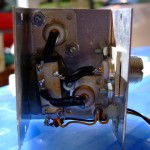 Two Position Switch Two Position Switch 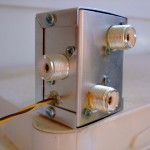 W4KAZ Switch W4KAZ Switch
The requirements are not critical for my low power application. It is simple enough. The relay is the P&B RTB14012F, a SPDT relay rated at 12A in its normal general purpose AC applications. This series of relays has been in use in my seven position switch for a couple of years now, and is in the same series of relays used in several high power switch project articles from NCJ. In this specific switch there are no losses that are measurable up through 6m. This was tested only with an ordinary watt meter into a dummy load, and applies to either output port of the switch. So far so good.
The only other components are a clamping diode, a 10nf bypass capacitor, a few bits of hook-up wire, and three coax connectors. The diode and the cap go across the coil on the relay to suppress nasty RF side-effects on the DC side of the circuit. The enclosure was easily the most expensive item. Total cost is about $12 USD. The 12v control cables are potted with hot glue. The enclosure is not water tight, but the switch will be mounted in or under a rain shield. The relay itself is sealed, so insects might be the only issue should they infiltrate the enclosure.
The switching controls are going to be in a yet to be determined integrated panel. That will add to the cost by the amount of the switch which will be mounted in the control panel. Cat5e will be used for all control cable runs.
I expect to place this puppy between the SixPak and the 40m antennas. Coax stubs for 40m will connect the SixPak to the two position switch. The default position(switch off) will be the primary antenna facing NE/SW. There will not be a grounded or unused position, as lightning protection will be added at the “radio A/radio B” positions of the SixPak. That arrangement will keep the radios isolated from one another via the SixPak, and unable to simultaneously select antennas resonant on the same band. (maybe….depends on the antennas used for the other bands, aina?)
With the addition of one relay and one extra control wire, it is easy to make a similar three or four position switch.
Sometimes simplicity is good, or as in this case, “good enough”.
By w4kaz, created on 2009.04.14 at 05:25:59 | last changed on 2020.06.23 at 08:35:17 | A Cool Accessory – aka Outboard Heat Management Project
The first extended period of use for the K2 came about during Field Day 2008. The top panel of a K2/100 is essentially one big heat sink. It soon became obvious the the K2 gets quite warm under continuous use – like when calling CQ endlessly for Field Day. The temporary FD solution was to re-position the fan to cover both the K2 and the operator.
Ten-Tec has a 12v external fan accessory, but it seemed like a good project to fill in the “waiting for family to get ready….” time.
I located a 3×6 heat sink that had been recovered from a dead computer CPU. As luck had it the heat sink had two parallel ridges along the bottom. Even luckier still, these ridges aligned well enough with the top of the K2 heat sink that it more or less “snapped on” to the top of the K2. The extra heat sink alone cooled the K2 a lot. But a fan would help.
Having a couple of four inch pie fans in the junk box, also recovered from computers, I was on my way to a ten minute project. Adding a couple of 5 inch rails cut from aluminum angle stock, a few nuts and bolts, and a dab of “JB Weld” epoxy, we get a nice heat sink/fan mash up. The K2 is now cool as ice. Functional – not esthetic!
 Top view of the Fan/heat sink Top view of the Fan/heat sink
Briefly, the fan is bolted to the aluminum angle. The angle is then epoxied to top of the the external heat 3×6 sink. A resistor is in-line to drop the fan speed by about half. The fan used is rated at 12v and 0.29 amps. Gathering a few half watt resistors, I came up with a 75 ohm 2 watt resistor. Putting the resistor in-line slowed the fan down and cut the fan noise completely. It still pushes plenty of air through the external heat sink. 75 ohms seemed to be the magic value needed to reduce the rpm’s “just enough”. Even very slightly higher resistance values cut the fan off completely. The whole fan mash up still is a snap-on, snap-off accessory – nothing changed on the K2.
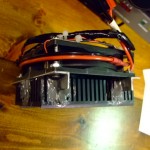 Heat Sink – Side Heat Sink – Side 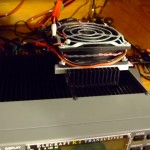 Ready for Cooling Ready for Cooling
–
? Custom Knobbery ?
There is lots of chatter over the years on the Elecraft mail list about a good replacement knob for K2. The stock knob is fine, but a slightly larger knob seems to work more to my personal tastes. The knob installed is from a Yaesu FT-840.
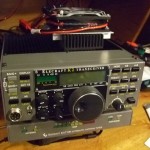 K2 customized K2 customized
The stock 840 knob has a plastic skirt, which can be seen in this RigPix photo. With the skirt left on the knob the display is obscured so it has been removed before installation on the K2. It appeared to have been held on it only a few drops of glue, so it could easily be re-installed later. That’s not an issue in this case, since the FT840 was involved in an unfortunate incident during a thunderstorm. 😮
The FT-840 knob is a perfect match to the Elecraft. It has a good feel, the tuning rate is slightly slower, and it even comes with its own “dimple”. Perfect. The 840 had a long shelf life, so this knob may be stocked for a while yet.
This knob would also be an improvement on the K3. I found the tuning on the K3 similar to the stock K2.
-more- at the K2 Impressions page
By w4kaz, created on 2009.04.11 at 06:56:50 | last changed on 2014.10.09 at 16:09:30 | The current idea to incorporate the SixPak into the antenna switching scheme will also require more remote switching on the down range side of the SixPak. I expect to have two or three 40m antenna choices, and two or three 20m antenna choices. Perhaps even on 15m and 10m. The 20m and 40m antennas will be dipoles at right angles to one another. The goal is to allow all antennas for a given band to plug into the appropriate port on the SixPak.
Currently, the 15m/10m rectangular loop is down. The new 40m dipolewill occupy the support rope previously used for the rectangular loop. There are now brandnew support lines shot into the biologicals that I expect to use for 10m and 15m loops. Right now, a diamond loop fed at the bottom is appealing, but it may be a pair ofdelta loops instead. The nature and locations of the newsupport lines and the surronding foliage will force a dipole to be Vee’d.Pushing the necessary limitations into an advantage indicates loops might be appropriate, or better than Vee’d dipoles. (Engineer the possible!)
Loops on 10m and 15m have appeal. The average height of a delta loop radiator(apex up) will be slightly lower than a Vee’d dipole at the same height, but a loop has a teeny bit of gain over a dipole. Both of the supports are at about 55 feet. Loops favoring EU should be good performers, if those bands ever become more reliable in that direction.
If the band switches are on the antenna side of the SixPak, each radio will be somewhat better isolated, and neither will be on an antenna that is resonant with the other radio’s antenna. For bands with multiple antennas, coaxial stubs could be placed between the SixPak and the antenna switch to provide harmonic filtering across all of the antennas. i.e., One coaxial filter per band. That will save on coax for the stubs.
I will probably choose to run separate control cables for these mono-band antenna switches, but it is possible to use the coax for the control voltages. Personal preference is to keep the apples separate from the oranges. Having a couple of hundred feet of Cat-5e laying around is also a factor. The control cable is already on hand in quantity. Note: The AD5X project linked below uses the coax for control voltages.
Simple one relay switches will allow choosing two antennas. That will fit in a small enclosure, and allow for very short lead lengths between so239 connectors. (??Notes on test…??)
The Ei7BA remote switch.
The AD5X remote switch.
A 6×2 switch project byK5LXP
A list of antenna switching projectlinks at DXzone
Amended 4/13/2009, 6:20pm
By w4kaz, created on 2009.04.10 at 06:12:02 | last changed on 2009.04.10 at 09:28:50 | Scores for the 2008 CW Sweepstakes have been published on the Web. The Sweepstakes LCR report is always worth looking over, since my error rate is still far too high on CW. For 2008, it looks like 44% of my errors were on the check number. The errors on the exchange was about 45%, and I busted only four callsigns. The score suffered dramatically, but I showed some incremental improvement over the 2007 Sweepstakes. I didn’t match the improvement in error rates I managed in the 2007 IARU, but it was better than the error rate of the 2007 CWSweeps.
The callsign copy needs to be 100%, but I made progress in that area over 2007.
The big problem seems to be busts on 7&8 and 2&3. Not a surprise. That mistake is accounting for the bulk of the cross check number busts. It is also the biggest problem in the exchange busts, where the year license is busted because of 7&8 or 2&3 busts. By correcting this copy error I will clean up almost 80 percent of my over all bust rate.
The other remaining errors are a mixed bag. There are several transposed digits in year licensed(e.g., where I logged 67 instead of the correct 76). This is a typing dyslexia that I often can catch as it is happening. So more attention to detail is needed when typing.
The rest are just generic inexusable errors. The callsign busts are fixable. “agn? ?”
Overall, I’m disappointed in the lack of overall improvement in clean copy. The score suffered mightily. But it still holds up as my best ever CW score, despite the inadequate copy. Besides, it was a blast.
K8AC, AA4NC, and N4AF all won their categories here in the Roanoke Division. Cool.
By w4kaz, created on 2009.04.09 at 06:22:12 | last changed on 2015.03.17 at 09:48:32 | Engineer the possible. The “best” is too often the enemy of “good enough”. Â If you wait until you have “The Best”, you may miss out on a lot of operating. Â Â Better to aim for “the best POSSIBLE”, i.e., what can be accomplished within the constraints of resources and time frame available.
The recently completed W4KAZ SO2R box is going to be something “New” in the KazShack. But the choices made in building it are all “old” technology. It is a case of engineering the possible.
This has been a project that I have flipped and flopped on. The choice made was based on practicality rather than “the best” approach. The best approach would have been to utilize a new computer and the USB rather than the LPT port. That choice implies using some of the newer CW keying technologies(Winkeyer or Microham). O’course, that would also entail blowing a couple of thousand dollars on the new off-the-shelf hardware, none of which is currently on hand. This approach I characterize as “New Hotness”, per Agent K from MIB. So, where do I get a couple thousand dollars I can divert to this frivolity? (Answer: convince Number One Son to join the Navy rather than go to college? Didn’t work…)
The alternative is to see what can be accomplished using “Old and Busted”.
It turns out that practically speaking, “Old and Busted” is perfectly serviceable, even if it is not quite so much fun as “New Hotness”. New Hotness certainly has an advantage in the effectiveness of generating the CW in a seperate piece of dedicated hardware. Nice, but not essential. New Hotness also uses current technology. Also nice, and also not essential.
The fact is that Old and Busted can be designed to competently and reliably perform the essential basic tasks required:
- Key the CW
- Control the radio TX focus
- Provide the band data or pass it along
- Be easily home brewed [!!!!!the most important criteria!!!!!]
- Be easily modified as needed/wanted/for experimentation
Even better yet, “Old and Busted” can be cobbled together very inexpensively relative to New Hotness. For my own part, the cobbling together is tremendously more satisfying than waiting for the postman or UPS truck for delivery.
O’course, price is also a big factor. But I have not found any home brew solutions utilizing USB. A hybrid solution could be derived by using the PIEXX SO2RXLAT device to convert USB to LPT type data. That seems like a workable bridge between old SO2R hardware and new computer tech. Possibly not ideal, but very plausible, and very attractive for those with money already invested in LPT hardware.
So, “Old and Busted” wins. Since I don’t like N1MM logging software, I don’t NEED a better shack computer. I can get by with a clunky old Win 98 box running good ole Writelog. Relying on an old CPU could be a reliability issue, but old CPU’s are free for the taking, and I already have several backup boxes on hand. The old boxes all have LPT ports, which is the approach that seems simplest for home brew of an SO2R box. A single LPT port can be configured to carry the CW, PTT, radio A/B switching, and also carries the band data for one of the radios.
So, Old and Busted wins out, at least for now.
Besides, I just can’t get my head wrapped around “needing” the latest-n-greatest technology for CW contesting. Really? Because CW is so cutting edge? Really?
It may all be moot. I may get the whole kit assembled and decide I don’t want to operate SO2R after trying it out. By going the old an busted route I have at the very least learned a lot by cobbling together several design ideas into a custom solution. That hands on education has more value to me than the cost of the New Hotness hardware. So even if I put the new toys aside after light usage, I win.
Engineer the possible. If you wait until you have “The Best”, you may miss out on a lot of operating.
By w4kaz, created on 2009.04.08 at 21:14:56 | last changed on 2009.04.08 at 21:14:56 | Wooowee. Wednesday night brought forth a trip to “New Orleans Foods and Spirits”. Recommended by the XYL’s neice as her favorite place. She has good cause.
Menu Items chosen around the table:
- Voo-doo crawfish stuffed rolls(appetizer)
- Crawfish and corn soup
- “Swomp” pasta
- Crawfish Stew
- Fried Shrimp salad
- Fried Catfish Platter
The menu had all of the other normal South Loozyana favorites. But it is difficult to sample them all.
Easily the best food I have had in three years. The crawfish stew was one of the better versions I have had, like -ever. That covers quite a lot of crawfish stews consumed in the days of my yoot’. O’course, the taste buds have been little exposed to such edible tidbits over this past decade, so my judgement could be suffering from delicacy deprivation.
NC BBQ is good, but it just ain’t nowhere close to the type of flavor explosions one can find back in the swampy homeland. There’s just nothing like really fresh seafood when it is expertly prepared. Despite the name, the restaurant is actually in Covington – but then so are most of the restauranteurs from New Awlinz. Caint say I blame them, since I got out while the gittin’ wuz good.
Everything else was good too. I stole a chunk of catfish from the n umber two son, and “home brewed” one of the other menu items: Fried catfish smothered with Crawfish stew. That was food too.
The Voo-Doo rolls turned out to be similar to egg rolls. The stuffing consisted of crawfish in a cheese sauce, with what tasted like pimento and a touch of jalepeno pepper. Extra Yum.
Even the hush puppies were top notch. Light and fluffy, no greasy taste. Yum.
I washed the stew down with a nice glass of Abita Amber from the tap. A good everyday brew that complemented the spicyness of the stew.
Sooo-WeeeeT.
I only regret not trying their gumbo, something I normally use to guage restaurant quality. The award for all time restaurant-made best gumbo goes to Phil’s Oyster Bar in Baton Rouge. Theirs is even better than my own. Usually.
I wonder if Phil’s is still open? RoadTrip!
|
|





